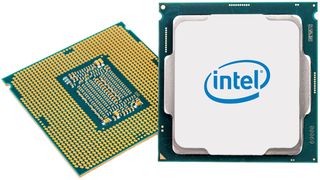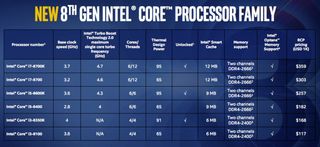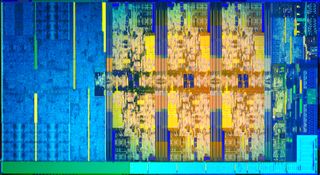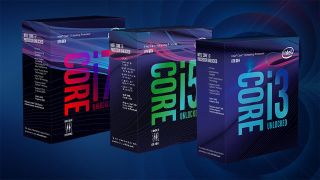Intel brews Coffee Lake for the desktop, hypes up gaming performance
Forget about Core i9, the new desktop i5 and i7 are the real excitement.

Having already launched 8th generation Core processors in mobile form (Kaby Lake Refresh), Intel on Sunday formally introduced its 8th generation desktop lineup (Coffee Lake), among which are the first six-core processors for mainstream consumers.
Sitting at the top of the stack is the Core i7-8700K, a 6-core/12-thread chip that Intel deems its "best gaming desktop processor ever." Unlike the nearly $2,000 Core i9-7980XE Skylake-X chip that favors more cores and cache over clockspeed, the Core i7-8700K is a far more sensible option for gamers, and one that can hit up to 4.7GHz in single-core turbo mode, and 4.6GHz when engaging all six cores. It has a base clockspeed of 3.7GHz, and 12MB of L3 cache.
Here is a look at the entire lineup:

Intel's previous generation Core i7-7700K (Kaby Lake) can be found online for around $300, so you're looking at $59 premium for Core i7-8700K. There is also the Core i7-8700 for $303, and it too is a 6-core/12-thread chip, but lacks an unlocked multiplier for easier overclocking. There's a bonus to the non-K chips, however, as they include cooling solutions.
"We are laser-focused on giving the enthusiast community the ultimate desktop experience, from chart-topping performance to a platform that can flex with their needs," said Anand Srivatsa, general manager of the Desktop Platform Group at Intel. "Our 8th Gen Intel Core desktop processors deliver tremendous improvements across the board and—for gamers, in particular—offer an unbeatable experience."
Coffee Lake is yet another processor family built on a 14-nanometer manufacturing process. It gives Intel another CPU line to promote as it readies 10nm Cannon Lake processors.
According to Intel's own testing, Coffee Lake offers gamers up to 25 percent more frames per second compared to Kaby Lake, "on popular and demanding games like Gears of War 4." However it's the streamers that might be the biggest beneficiaries—Intel claims you can game + stream + record up to two times faster versus a three-year-old machine running a Core i7-4790K (Devil's Canyon) CPU.
PC Gamer Newsletter
Sign up to get the best content of the week, and great gaming deals, as picked by the editors.

The big news is that Intel is finally adding more cores to its mainstream processor line, but perhaps more surprising is that it includes the Core i3 as well as Core i5/i7 products. We give AMD a lot of credit for forcing Intel's hand here, as Ryzen has finally brought some much-needed competition to the CPU market. On the other hand, this is really a case of "it's about damn time, Intel."
Intel's first quad-core parts for desktop came out in 2006, aka Kentsfield / Core 2 Quad. That was the last time Intel had a unified consumer desktop platform, and the move to Core i7 in late 2008 came with the creation of the 'enthusiast' socket LGA1366 platform. The mainstream LGA1156 platform came a year later, with quad-core plus Hyper-Threading (4-core/8-thread, or 4C/8T) parts like the i7-860 and i7-870. Since then, Intel's mainstream platform has been through three socket updates (LGA1155, LGA1150, and most recently LGA1151), and six more generations, but the top processors have remained 4C/8T.
Coffee Lake gives us the long-awaited upgrade to 6-core, but it feels a lot like a knee-jerk reaction to Ryzen. It first appeared on the roadmaps in 2016, and at the time it was expected to launch in 2018. Now it's coming out in late 2017, marking the third major CPU platform launch from Intel this year. It's also Intel's fourth architecture to use 14nm lithography, so Intel went from tick-tock to processor-architecture-optimization, and now it's doing processor-architecture-optimization1-optimization2 (5th Gen Broadwell, 6th Gen Skylake, 7th Gen Kaby Lake, and now 8th Gen Coffee Lake).
Besides the increase in core counts, L3 cache sizes have increased by 50 percent on all three levels, so 12MB for i7, 9MB for i5, and 6MB for i3. Official memory support has also improved from DDR4-2133 in Skylake to DDR4-2400 in Kaby Lake, and now DDR4-2666 in Coffee Lake (but still 'only' DDR4-2400 for the Core i3 parts). Not that official memory support really matters—we've been using DDR4-3200 since Skylake launched without issues.
The integrated graphics remains the same Intel HD Graphics 630 as before, something not really fit for gaming purposes. The total number of PCIe lanes remains the same, 16 plus four more DMI 3.0 lanes that connect to the PCH. Adding more PCIe lanes from the CPU would require a change in socket, and Intel is leaving that market to its HEDT (High-End Desktop) processors like Core i9. Most users don't really need the additional PCIe lanes, but there's also little need for the platform update.
Intel Z370 is for Coffee Lake only
The Coffee Lake launch is not without a bit of controversy. To go along with the new CPUs, Intel launched its Z370 chipset. Z370 motherboards use the same LGA 1151 socket as Z270 boards, but do not support Kaby Lake processors.
"For the platform, the new Intel Z370 chipset provides improved power delivery needed for the new 6-core processors to reach their maximum performance as well as enhanced package power delivery for overclocking and memory routing support. More than 50 new motherboard and system designs will be available from a variety of leading providers," Intel said.
Word on the web is that Z370 motherboards are capable of supporting Kaby Lake processors, but Intel is not allowing it—the company has instructed motherboard makers to block support through the BIOS, Guru3D says. Of course, if you're buying a new motherboard with a new chipset, you're probably looking at a CPU upgrade as well. But for those who want to jump on the latest platform while either carrying over their existing CPU or scoring a deal on a discounted Kaby Lake chip, it is not an option right now.
The opposite is also true—you can't plop a Coffee Lake processor into a Z270 motherboard and have it fire up. So if you're interested in Coffee Lake, you're looking at a platform upgrade.

Given that Intel has remained our primary choice for gamers, despite Ryzen's inroads, the new 8th Gen parts are mostly just a nice upgrade for those looking at new systems. Now you have the option for 6C/6T at under $200, with the previous generation Core i5 parts now effectively reclassified as Core i3. Something else to note is that, unlike the Skylake-X parts, Coffee Lake CPUs likely stick with a ring bus topology instead of the mesh topology used for the higher core count parts. That's good, because for lower core counts the ring bus appears to perform better.
We're excited to see Intel finally move its mainstream platform beyond quad-core parts, but then we've had 6-core Intel processors for a long time. Core i7-980X came out over seven years ago for LGA1366, albeit at $999. Since then, we've had 6-core parts priced at $583 (i7-980 and i7-3930K), then $555 (i7-4930K), and the i7-5820K dropped the price to $389 over three years ago. The Core i5-8400 is arguably the most interesting part, 6C/6T starting at just $182.
8th Gen Core will officially launch on October 5, at which time we'll have full benchmarks and reviews. However things shake out, 2017 is going down as the most exciting year in CPUs in recent history—even if most of the excitement comes by way of product launches rather than massive generational improvements in performance.
Jarred's love of computers dates back to the dark ages when his dad brought home a DOS 2.3 PC and he left his C-64 behind. He eventually built his first custom PC in 1990 with a 286 12MHz, only to discover it was already woefully outdated when Wing Commander was released a few months later. He holds a BS in Computer Science from Brigham Young University and has been working as a tech journalist since 2004, writing for AnandTech, Maximum PC, and PC Gamer. From the first S3 Virge '3D decelerators' to today's GPUs, Jarred keeps up with all the latest graphics trends and is the one to ask about game performance.
Most Popular






